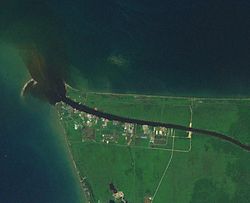
Back Batang Baram CEB Sungai Baram German Bawang Baram DTP Baram French Sungai Baram ID Baram Italian Sungai Baram Malay பாராம் ஆறு Tamil
| Baram River | |
|---|---|
 Mouth of Baram river with black water plume | |
 | |
| Native name | Sungai Baram (Malay) |
| Location | |
| Country | Malaysia |
| Physical characteristics | |
| Source | |
| • location | Borneo |
| Mouth | |
• location | at Miri into South China Sea |
• elevation | Sea level |
| Length | 400 km (250 mi) |
| Basin size | 22,100 km2 (8,500 sq mi)[2] |
| Discharge | |
| • location | Baram Delta, South China Sea |
| • average | 1,590 m3/s (56,000 cu ft/s)[1] |
| Basin features | |
| Tributaries | |
| • left | Tutoh River, Temala River, Pelutan River, Patah River, Akah River, Buang River, Selaan River, Serungo River |
| • right | Arang River, Tinjar River, Julan River, Silat River, Moh River |

The Baram River (Malay: Sungai Baram) is a river in Sarawak on the island of Borneo. The river originates in the Kelabit Highlands, a watershed demarcated by the Iran Mountains of East Kalimantan, which form a natural border with Sarawak. The river flows westwards through tropical rainforest to the South China Sea.[3][4] The Baram River terminates in a delta, which is subdivided into two units: East Barma Delta of Middle-Late Miocene age and West Baram Delta of Late Miocene-Quaternary age.[5] The western unit is composed of mudstones enriched in organic components (total organic carbon content is more than 1.0 wt.%) which constitute substantial oil and gas reserves.[6]
The Baram river basin, an area of some 10,000 square miles (30,000 km2), has been part of Sarawak since it was ceded to the White Rajah of Sarawak by the then sultan of Brunei in 1882, for a perpetual annual payment of 6,000 dollars.[7]
The river is crossed not far from its mouth by the Miri-Baram Highway, Federal Route 22, on the Batang Baram Bridge opened in 2003. Some 100 km upstream lies the town of Marudi.[8]
- ^ Prabakaran, Krishnamurthy (2017). "Environmental Geochemistry of the Lower Baram River, Borneo" (PDF).[permanent dead link]
- ^ Ministry of Natural Reserves and Environment, Malaysia: National Water Resources Study, Vol. 29 - Sarawak[permanent dead link] (PDF; 72,3 MB) page 74
- ^ Reed L. Wadley (2005). Histories of the Borneo Environment. KITLV Press. ISBN 90-6718-254-0.
- ^ Louisiana State University
- ^ Hutchison, Charles (2005). Geology of North-West Borneo: Sarawak, Brunei and Sabah. Amsterdam: Elsevier. ISBN 978-0-444-51998-6.
- ^ Togunwa, Olayinka; Abdullah, Wan (2017-08-10). "Geochemical characterization of Neogene sediments from onshore West Baram Delta Province, Sarawak: paleoenvironment, source input and thermal maturity". Open Geosciences. 9 (1): 302–313. doi:10.1515/geo-2017-0025. ISSN 2391-5447.
- ^ The Pagan Tribes of Borneo, retrieved 22-05-2007 Archived September 28, 2007, at the Wayback Machine
- ^ "处处垃圾 影响环境 美里河污染严重 (Garbage everywhere Miri River environmental pollution)". Xinhua Daily (Shihua News) (in Chinese). 15 June 2014. Archived from the original on 16 June 2014. Retrieved 14 July 2017.